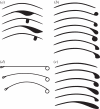Flight in slow motion: aerodynamics of the pterosaur wing
- PMID: 21106584
- PMCID: PMC3097835
- DOI: 10.1098/rspb.2010.2179
Flight in slow motion: aerodynamics of the pterosaur wing
Abstract
The flight of pterosaurs and the extreme sizes of some taxa have long perplexed evolutionary biologists. Past reconstructions of flight capability were handicapped by the available aerodynamic data, which was unrepresentative of possible pterosaur wing profiles. I report wind tunnel tests on a range of possible pterosaur wing sections and quantify the likely performance for the first time. These sections have substantially higher profile drag and maximum lift coefficients than those assumed before, suggesting that large pterosaurs were aerodynamically less efficient and could fly more slowly than previously estimated. In order to achieve higher efficiency, the wing bones must be faired, which implies extensive regions of pneumatized tissue. Whether faired or not, the pterosaur wings were adapted to low-speed flight, unsuited to marine style dynamic soaring but adapted for thermal/slope soaring and controlled, low-speed landing. Because their thin-walled bones were susceptible to impact damage, slow flight would have helped to avoid injury and may have contributed to their attaining much larger sizes than fossil or extant birds. The trade-off would have been an extreme vulnerability to strong or turbulent winds both in flight and on the ground, akin to modern-day paragliders.
Figures




Similar articles
-
Constraints on the wing morphology of pterosaurs.Proc Biol Sci. 2012 Mar 22;279(1731):1218-24. doi: 10.1098/rspb.2011.1529. Epub 2011 Sep 28. Proc Biol Sci. 2012. PMID: 21957137 Free PMC article.
-
On the size and flight diversity of giant pterosaurs, the use of birds as pterosaur analogues and comments on pterosaur flightlessness.PLoS One. 2010 Nov 15;5(11):e13982. doi: 10.1371/journal.pone.0013982. PLoS One. 2010. PMID: 21085624 Free PMC article.
-
Biomechanics of the unique pterosaur pteroid.Proc Biol Sci. 2010 Apr 7;277(1684):1121-7. doi: 10.1098/rspb.2009.1899. Epub 2009 Dec 9. Proc Biol Sci. 2010. PMID: 20007183 Free PMC article.
-
How the pterosaur got its wings.Biol Rev Camb Philos Soc. 2015 Nov;90(4):1163-78. doi: 10.1111/brv.12150. Epub 2014 Oct 31. Biol Rev Camb Philos Soc. 2015. PMID: 25361444 Review.
-
Bat flight: aerodynamics, kinematics and flight morphology.J Exp Biol. 2015 Mar;218(Pt 5):653-63. doi: 10.1242/jeb.031203. J Exp Biol. 2015. PMID: 25740899 Review.
Cited by
-
Morphometric assessment of pterosaur jaw disparity.R Soc Open Sci. 2018 Apr 25;5(4):172130. doi: 10.1098/rsos.172130. eCollection 2018 Apr. R Soc Open Sci. 2018. PMID: 29765665 Free PMC article.
-
Forelimb muscle activation patterns in American alligators: Insights into the evolution of limb posture and powered flight in archosaurs.J Anat. 2024 Jun;244(6):943-958. doi: 10.1111/joa.14011. Epub 2024 Jan 19. J Anat. 2024. PMID: 38242862 Free PMC article.
-
Pterosaurs evolved a muscular wing-body junction providing multifaceted flight performance benefits: Advanced aerodynamic smoothing, sophisticated wing root control, and wing force generation.Proc Natl Acad Sci U S A. 2021 Nov 2;118(44):e2107631118. doi: 10.1073/pnas.2107631118. Proc Natl Acad Sci U S A. 2021. PMID: 34663691 Free PMC article.
-
Constraints on the wing morphology of pterosaurs.Proc Biol Sci. 2012 Mar 22;279(1731):1218-24. doi: 10.1098/rspb.2011.1529. Epub 2011 Sep 28. Proc Biol Sci. 2012. PMID: 21957137 Free PMC article.
-
How did extinct giant birds and pterosaurs fly? A comprehensive modeling approach to evaluate soaring performance.PNAS Nexus. 2022 Mar 10;1(1):pgac023. doi: 10.1093/pnasnexus/pgac023. eCollection 2022 Mar. PNAS Nexus. 2022. PMID: 36712794 Free PMC article.
References
-
- Wellnhofer P. 1991. The illustrated encyclopedia of pterosaurs. London, UK: Salamander
-
- Unwin D. M. 2005. The pterosaurs: from deep time. New York, NY: Pi Press
-
- Kellner W. A., Wang X., Tischlinger H., Campos D., Hone D. W. E., Meng X. 2009. The soft tissue of Jeholopterus (Pterosauria, Anurognathidae, Batrachognathinae) and the structure of the pterosaur wing membrane. Proc. R. Soc. B 277, 321–32910.1098/rspb.2009.0846 (doi:10.1098/rspb.2009.0846) - DOI - DOI - PMC - PubMed
-
- Marchaj C. A. 1979. Aero-hydrodynamics of sailing. London, UK: Adlard Coles Nautical
-
- Claessens L. P. A. M., O'Connor P. M., Unwin D. M. 2009. Respiratory evolution facilitated the origin of pterosaur flight and aerial gigantism. PLoS ONE 4, e4497.10.1371/journal.pone.0004497 (doi:10.1371/journal.pone.0004497) - DOI - DOI - PMC - PubMed
MeSH terms
LinkOut - more resources
Full Text Sources
Miscellaneous

